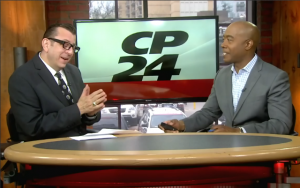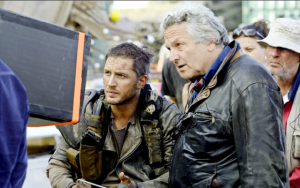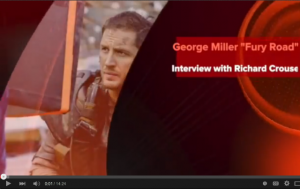RICHARD’S WEEKEND MOVIE REVIEWS FROM CP24! FRIDAY MAY 15, 2015.
 Richard’s CP24 reviews for “Mad Max: Fury Road,” “Pitch Perfect 2″ and “Good Kill.”
Richard’s CP24 reviews for “Mad Max: Fury Road,” “Pitch Perfect 2″ and “Good Kill.”
Watch the whole thing HERE!
 Richard’s CP24 reviews for “Mad Max: Fury Road,” “Pitch Perfect 2″ and “Good Kill.”
Richard’s CP24 reviews for “Mad Max: Fury Road,” “Pitch Perfect 2″ and “Good Kill.”
Watch the whole thing HERE!
 Richard’s “Canada AM” reviews for “Mad Max: Fury Road,” “Pitch Perfect 2” and “Good Kill.”
Richard’s “Canada AM” reviews for “Mad Max: Fury Road,” “Pitch Perfect 2” and “Good Kill.”
Watch the whole thing HERE!
 By Richard Crouse – Metro In Focus
By Richard Crouse – Metro In Focus
George Miller has made pigs talk and penguins tap dance. He’s been a doctor and a film director. Among the bold faced names on his resume are the titles Babe: A Pig in the City, The Witches of Eastwood, Happy Feet 1 and 2 and Lorenzo’s Oil. One name, however, looms larger than the rest.
Mad Max. Over the course of three films—Mad Max, Mad Max 2: The Road Warrior and Beyond Thunderdome—he introduced the world to post apocalyptic warrior Max Rockatansky, made Mel Gibson a superstar, defined dystopian cinema for a generation or two and created the phrase, “Two men enter, one man leaves.”
This weekend, thirty years after the release of the last Mad Max movie, Miller revisits the character in Mad Max: Fury Road, a reboot starring Tom Hardy and Charlize Theron.
The seventy-year-old director, who raised money to make the first film by working as an Emergency Room Doctor, says the goal of the new movie was to make it “uniquely familiar.”
After years of “following the CG evolution,” using computer generated images to create beautiful animated films, he was keen to go back to “old school” filmmaking “with real cars and real people and real desert.” That means, unlike the Avengers and their ilk, respecting the laws of physics by using practical effects and keeping the action earthbound. In other words, in a call back to the original films, when a car blows up it doesn’t rocket into space. Instead it explodes spectacularly but organically. The wild action you see in Fury Road are actual stunts performed by stunt men and women and not generated by a clever computer operator in a studio.
“It was like going back to your old home town and looking at it anew,” he says.
Miller reveals he originally created Max’s wasteland world while practising medicine.
“I worked for two and half years in a big city hospital. I stayed registered right up past Mad Max 2: Road Warrior. I never even thought there’d be a career. I stayed as a doctor on the first Mad Max because we kept running out of money in postproduction. Then I stayed through to the second Mad Max because if you are doing stunts you are obliged to have a doctor on set. There weren’t big budgets so I ended up running a clinic during lunch time tending to cuts, sunburns, scrapes and all that.”
His two careers have much in common, he says, adding he was “was privileged with a unique point of view as a doctor.”
“I don’t think I’d be the filmmaker I am unless I had that medical education, in two very direct ways. Both of them have a lot of problem solving in there. But the most important way is that as a doctor you are looking at people in extremis from many points of view. You look inside of people. You see people during birth and death and so on. Through microscopes; a lens. So you’re looking from many, many points of view. That’s exactly what you do in cinema. Huge wide shots with massive crowds or you’re looking right down inside someone’s brain, someone’s head.”
As for plans to make another Mad Max right away, he says, “That’s a bit like asking a woman who’s just given birth if she’s going to have another baby.”
 The ghostly War Boys of “Mad Max: Fury Road” have a catchy mantra they recite as they go into battle. “I live. I die. I live again!” In some ways it could be the refrain for the series. Begun as a down-and-dirty punk rock vision of a post-apocalyptic Australia, the 1979 no-budget movie made a star out of Mel Gibson and spawned a mini-franchise of two more films, “The Road Warrior” and “Beyond Thunderdome.”
The ghostly War Boys of “Mad Max: Fury Road” have a catchy mantra they recite as they go into battle. “I live. I die. I live again!” In some ways it could be the refrain for the series. Begun as a down-and-dirty punk rock vision of a post-apocalyptic Australia, the 1979 no-budget movie made a star out of Mel Gibson and spawned a mini-franchise of two more films, “The Road Warrior” and “Beyond Thunderdome.”
The George Miller films lived, died and now live again courtesy of “Mad Max: Fury Road,” an out-of-control reboot that recreates Max Rockatansky’s dystopian world and then races like hell through it, laying rubber all the way.
Set in an arid, inhospitable world where a snack of raw lizard constitutes a meal, Max (Tom Hardy) is a man who has lost everything, Haunted by “those he could not protect” he is now “a man reduced to a single instinct—survival.” Captured by henchmen of Immortan Joe (Hugh Keays-Byrne, who played Toecutter in the original “Mad Max”), a despot who hoards precious natural resources and only sparingly shares water with his subjects—Don’t take too much water, he says, you will only come to resent it when it isn’t there.—Max is turned into a blood bank for an ailing war boy named Nux (Nicholas Hoult). Subjected to a life of confinement and drained of his own natural resources, Max sees a chance for freedom when Nux and others do battle against Imperator Furiosa (Charlize Theron), a former warrior turned rogue. She’s driving the imposing War Rig—imagine a Monster Truck with an attitude—across the wasteland. With her are Immortan Joe’s five wives—Splendid (Rosie Huntington-Whiteley), Capable (Riley Keough), Toast (Zoë Kravitz), The Dag (Abbey Lee Kershaw) and Fragile (Courtney Eaton)—a natural resource he desperately wants back. Max and Furiosa form an uncomfortable alliance to battle the forces of evil and make it across the desert to Furiosa’s childhood home, a green oasis.
It’s been thirty years since there was a new “Mad Max” movie but “Fury Road” was worth the wait. The years have not stilled Miller’s restless camera or his outrageous way with steampunk influenced design or character names. If Imperator Furiosa isn’t the best character name of the year, I don’t know what is. Her title, however, might as well have been Mad Maxine as she is more the focus of the story than the titular character.
It is a chase movie where characters chase immortality, a new life in a better place, love and one another across a vivid landscape. Gone are the grey tones of dystopian movies like “The Road.” In its place is a dusty but vibrant backdrop that frames the non-stop action. Miller keeps the pedal to the metal but unlike the recent “Avengers: Age of Ultron,” which had a similar angle of attack, he keeps the action earthbound. The laws of physics are respected—when a car blows up it doesn’t rocket into space for instance—by the director’s use of practical effects. Most everything you see on screen are actual stunts performed by real people and not generated by a clever computer operator in a studio later on. The organic nature of most of (but not quite all) the visuals gives the movie extra torque, adding a sense of danger and realism (no matter how unreal the situation) to the large set pieces that make up the bulk of the film.
Hardy pulls his weight as Max. His powerful physicality mixed with a haunted look—maybe we should call him Passive Aggressive Max—and gearbox permanently shifted to survival makes him an imposing center of the film, but it is Theron who dominates.
As Furiosa she lives up to her name as a force to be reckoned with. She’s a one-armed bandit (literally) who not only provides much of the action in the film, but its heart as well.
The real star, however, is Miller. Thirty years after he last played in Mad Max’s world he revisits it with a film that doesn’t feel like a sequel or a reboot, but a fresh look at an familiar character. His off-the-wall sensibility and demented Hot Wheels style designs give the movie a look and feel that no other director could replicate.
 Richard talks with George Miller regarding his film “Mad Max: Fury Road”
Richard talks with George Miller regarding his film “Mad Max: Fury Road”
George Miller on his life as a doctor before taking up film making full time: “I worked for two and half years in a big city hospital. I stayed registered right up past Mad Max 2: Road Warrior. I never even thought there’d be a career. I was still interested in medicine. I went through medical school with my twin brother. I stayed as a doctor on the first Mad Max because we kept running out of money in post production. I was working and it took over a year to cut that film. Then I stayed through to the second Mad Max because if you are doing stunts you are obliged to have a doctor on set. There weren’t big budgets son I ended up running a clinic during lunch time tending to cuts, sunburns, scrapes and all that. The, as time went on, I realized from my twin brother that… I kept losing the knowledge and not keeping up with it. You can’t do both.”
 This week I read with cringing amusement some of the more withering critical reactions to former underwear model Rosie Huntington-Whiteley’s performance in Transformers: Dark of the Moon. Total Film’s Neil Smith wrote that she sucks “the life out of every scene she appears in like some pneumatic Dyson sexbot,” while Chris Hewitt of Empire said, “You’ll believe a robot can fly, but you won’t believe a Huntington-Whiteley can talk.”
This week I read with cringing amusement some of the more withering critical reactions to former underwear model Rosie Huntington-Whiteley’s performance in Transformers: Dark of the Moon. Total Film’s Neil Smith wrote that she sucks “the life out of every scene she appears in like some pneumatic Dyson sexbot,” while Chris Hewitt of Empire said, “You’ll believe a robot can fly, but you won’t believe a Huntington-Whiteley can talk.”
I even posted some of these on my facebook page without thinking about it too much; nothing like a funny jab from a bitchy critic to brighten up the day. I’ve cracked wise myself a few times. Years ago I wrote “the former commercial director has a knack for making everything look shiny but having great taste doesn’t make a great film director any more than great taste makes a Snicker’s bar a gourmet meal,” about Transformers filmmaker Michael Bay.
Now, that’s a pretty good line, if I do say so myself, but it’s also a cheap shot and I sometimes find myself pondering the merits of including puns and jokes in reviews.
Having said that one of my favorite reviews of all time is also the shortest. In 1986 former Genesis guitarist Steve Hackett and Yes and Asia guitarist Steve Howe released a vanity project simply titled GTR, a hip abbreviation of the word “guitar.” Reviewing the album in Musician magazine J.D. Considine wasted no ink, writing simply “GTR-SHT.”
Considine says it the most famous thing he ever wrote and the band claimed the popularity of the review actually helped sales of the record. GRT went gold and produced the hit single When the Heart Rules the Mind.
Others haven’t been so gracious in their acceptance of bad reviews. The Story Sisters novelist Alice Hoffman responded poorly to Roberta Silman’s review of book in the Boston Globe. Her reaction? 27 angry tweets, one of which included Silman’s phone number, e-mail address and urged follwers to, “Tell her what u think of snarky critics.”
Hoffman eventually apologized for the outburst and was the subject of a number of “How not to respond to a bad review” articles.
Darren Aronofsky was a bit more direct when he chastised New York Press critic Armond White at last year’s New York Film Critics Circle Awards. From the stage he said, “Keep it up, because you give us all another reason not to read New York Press,” while staring White down.
White, who panned Aronofsky’s Black Swan and once suggested that director Noah Baumbach’s mother should have had a “retroactive abortion,” responded with, “That’s all right. Darren reads me. That’s all I want. And because he reads me, he knows the truth.”
There’s a life lesson for Ms. Huntington-Whiteley in all of this. Too bad she won’t have time to learn it this weekend. She’ll be too busy counting the truckloads of money her movie’s going to make to pay too much attention to the reviews.